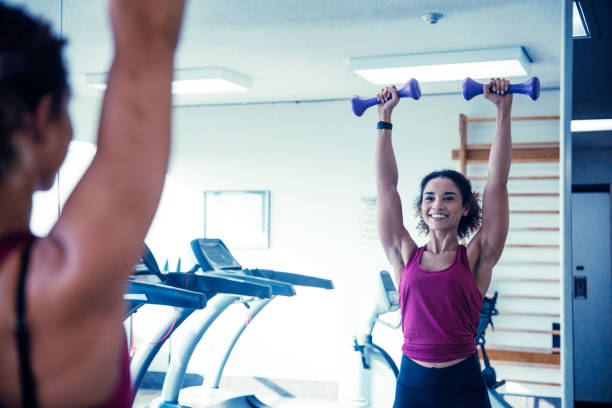(BlackFitness101.com) As a fitness trainer, I’ve seen many individuals eager to jump into their workout routines, brimming with enthusiasm and determination. While this excitement is fantastic, there’s one critical aspect of working out that often gets overlooked or underestimated—proper form. Whether you’re lifting weights, doing bodyweight exercises, or engaging in cardio activities, maintaining the correct form is paramount to your success and longevity in fitness.
Proper form is the foundation of any effective workout regimen. It ensures that you’re targeting the right muscles, reducing the risk of injury, and maximizing the benefits of each exercise. In this article, we will delve deep into the importance of proper form, exploring how it impacts your workouts, how to achieve it, and the consequences of neglecting it.

What Is Proper Form?
Before we dive into the benefits and importance of proper form, it’s essential to understand what it actually entails. Proper form refers to the correct positioning and movement of your body during exercise. This includes everything from the alignment of your joints and the engagement of specific muscle groups to the way you breathe and the tempo at which you perform the exercise.
Every exercise has a specific form that optimizes its effectiveness. For example, when performing a squat, proper form would involve keeping your back straight, chest up, knees tracking over your toes, and lowering your body until your thighs are parallel to the ground. This precise positioning ensures that you’re working the intended muscles—primarily the quadriceps, hamstrings, and glutes—while minimizing strain on your lower back and knees.
Why Proper Form Matters
1. Injury Prevention
One of the most significant reasons to prioritize proper form is to prevent injuries. Incorrect form places unnecessary stress on your joints, ligaments, and muscles, which can lead to acute injuries like strains, sprains, or even more severe issues such as herniated discs or torn ligaments. Over time, consistently poor form can also result in chronic conditions like tendinitis or stress fractures.
For instance, lifting weights with improper form can lead to muscle imbalances, where some muscles become overdeveloped while others remain underdeveloped. This imbalance can cause issues with posture and lead to injuries in other areas of the body. A common example is shoulder impingement, which often occurs when individuals perform overhead presses with their shoulders rounded forward, placing excessive stress on the shoulder joint.
2. Maximizing Muscle Engagement
Proper form ensures that you’re engaging the correct muscles during your workout. This is crucial for building strength, muscle tone, and endurance. When your form is off, other muscles may compensate for the intended muscle group, reducing the effectiveness of the exercise.
Take the bench press, for example. If you allow your elbows to flare out too much during the lift, you might end up putting more stress on your shoulders rather than focusing on your chest muscles. By maintaining proper form—keeping your elbows at a 45-degree angle and your shoulder blades retracted—you can better target your pectoral muscles, leading to greater strength gains and muscle hypertrophy.
3. Improved Efficiency and Performance
When you use proper form, your workouts become more efficient. Each repetition you perform is more effective, meaning you can achieve better results in less time. This efficiency also translates to better overall performance, whether you’re aiming to lift heavier weights, run faster, or complete more reps.
For athletes and fitness enthusiasts aiming to improve their performance in a specific sport or activity, proper form is especially critical. In sports like swimming or running, where technique is key, even minor adjustments in form can lead to significant improvements in speed, endurance, and power.
4. Enhanced Mind-Muscle Connection
The mind-muscle connection refers to the ability to consciously engage and control the muscles you’re working during an exercise. Proper form plays a vital role in developing this connection. When you’re mindful of your form, you’re more likely to feel the muscle contracting and stretching throughout the movement, which can enhance muscle activation and growth.
For example, during a bicep curl, focusing on the contraction of your bicep as you lift the weight, and the stretch as you lower it, can make the exercise more effective. This conscious engagement not only improves muscle activation but also helps prevent cheating, where you might use momentum rather than muscle strength to complete the movement.
5. Long-Term Sustainability
Fitness is a lifelong journey, and sustainability is key to long-term success. Proper form ensures that you can continue to exercise safely and effectively for years to come. By reducing the risk of injury and maximizing the benefits of your workouts, you’re more likely to stay motivated and consistent with your fitness routine.
When individuals neglect proper form and push themselves too hard too quickly, they often experience burnout, injuries, or plateaus in progress. These setbacks can be discouraging and lead to a loss of motivation. On the other hand, those who prioritize form can gradually increase the intensity and complexity of their workouts, leading to steady and sustainable progress.
How to Achieve Proper Form
Achieving proper form requires a combination of knowledge, practice, and mindfulness. Here are some steps to help you maintain correct form in your workouts:
1. Educate Yourself
The first step to proper form is understanding the correct technique for each exercise. This can be achieved through various methods:
- Professional Guidance: Working with a certified personal trainer is one of the best ways to learn proper form. A trainer can provide personalized feedback, correct your posture, and offer modifications to suit your fitness level.
- Online Resources: There are countless videos, articles, and tutorials available online that demonstrate proper form for various exercises. Be sure to use reputable sources, such as fitness professionals or well-established fitness websites.
- Fitness Classes: Group fitness classes led by experienced instructors can also be a great way to learn proper form. The instructor can provide cues and corrections as you perform the exercises.
2. Start with the Basics
If you’re new to a particular exercise or fitness routine, it’s essential to start with the basics. This means using lighter weights or bodyweight exercises to master the form before progressing to more challenging variations.
For example, if you’re new to weightlifting, start with basic movements like squats, deadlifts, and bench presses using an empty barbell or light dumbbells. Focus on mastering the form and movement patterns before gradually increasing the weight.
3. Use a Mirror or Video Feedback
A mirror can be an invaluable tool for checking your form during workouts. It allows you to see your body alignment and make real-time adjustments. However, be careful not to rely solely on the mirror, as this can lead to a loss of focus on the exercise itself.
Video feedback is another effective method for assessing your form. Recording yourself while performing exercises can help you identify any deviations from proper form that you might not notice in the moment. You can review the footage and make adjustments as needed.
4. Focus on Posture and Alignment
Proper posture and alignment are the cornerstones of good form. Here are some general tips to keep in mind:
- Neutral Spine: Maintain a neutral spine position, where your back is neither excessively arched nor rounded. This alignment protects your spine and allows for better muscle engagement.
- Core Engagement: Engage your core muscles throughout the exercise to stabilize your torso and protect your lower back.
- Joint Alignment: Ensure that your joints are aligned correctly during exercises. For example, during a squat, your knees should track over your toes, and your hips should be aligned with your shoulders.
- Breathing: Proper breathing is often overlooked but plays a crucial role in maintaining form. Inhale during the eccentric phase (when lowering the weight) and exhale during the concentric phase (when lifting the weight). This helps stabilize your core and maintain proper alignment.
5. Practice Mindfulness
Mindfulness is about being present and fully aware of your body during exercise. This means paying attention to your form, the muscles you’re engaging, and the way your body feels throughout each movement.
- Slow Down: Rushing through exercises can lead to sloppy form. Take your time with each repetition, focusing on control and precision rather than speed.
- Listen to Your Body: If something doesn’t feel right or if you experience pain (other than the typical muscle burn), stop and reassess your form. Pain is often a signal that something is off, and continuing could lead to injury.
6. Use Proper Equipment
Using the right equipment can also aid in maintaining proper form. This includes:
- Supportive Footwear: Proper shoes provide the necessary support and stability for your feet and ankles, which is especially important during exercises like running, jumping, or lifting weights.
- Weightlifting Belt: For heavy lifting exercises, a weightlifting belt can help support your lower back and maintain a neutral spine.
- Resistance Bands: Resistance bands can be used to assist with certain exercises, helping you maintain proper form as you build strength.
7. Seek Feedback
Even experienced lifters can benefit from feedback on their form. Don’t hesitate to ask a trainer, workout partner, or even an experienced gym-goer to watch your form and provide constructive criticism. Sometimes, an outside perspective can catch details you might have missed.
Consequences of Poor Form
Neglecting proper form can have several negative consequences, some of which can be long-lasting. Here’s what can happen when you ignore the importance of form in your workouts:
1. Increased Risk of Injury
As mentioned earlier, improper form significantly increases the risk of injury. This can range from minor strains and sprains to more severe injuries that require medical intervention or even surgery. For example, performing a deadlift with a rounded back can lead to a herniated disc, a painful condition that may take months to heal.
Injuries not only hinder your progress but can also take a toll on your motivation and confidence. Recovering from an injury often requires a break from your regular workout routine, which can set you back in your fitness goals.
2. Muscle Imbalances
Poor form can lead to muscle imbalances, where some muscles become overdeveloped while others remain underdeveloped. This can affect your posture, movement patterns, and overall strength. For example, if you consistently perform chest exercises with improper form, you may develop tight chest muscles and weak upper back muscles, leading to rounded shoulders and poor posture.
Muscle imbalances can also contribute to joint pain and increase the risk of injury. Correcting these imbalances often requires targeted exercises and physical therapy, which can be time-consuming and frustrating.
3. Reduced Effectiveness
When you use improper form, you’re not getting the full benefit of the exercise. This means you might be wasting time and energy on movements that aren’t effectively targeting the intended muscles. As a result, your progress may be slower, and you may not achieve the desired results.
For example, if you perform a squat with your weight shifting forward onto your toes, you’re likely putting more stress on your knees and less on your glutes and hamstrings. This can limit your ability to build strength and muscle in those areas, ultimately reducing the effectiveness of your workout.
4. Plateaus in Progress
If you consistently use poor form, you may eventually hit a plateau where you’re no longer seeing improvements in your strength, endurance, or physique. This is because your body isn’t being challenged in the right way, and you may not be engaging the correct muscles to stimulate growth and adaptation.
Overcoming a plateau often requires going back to basics and reassessing your form. This can be frustrating, especially if you’ve been working hard but not seeing the results you expected.
5. Compromised Long-Term Health
In the long run, consistently poor form can have a detrimental impact on your overall health. Chronic joint pain, poor posture, and movement dysfunctions can develop over time, leading to a decreased quality of life.
For example, poor posture resulting from muscle imbalances can contribute to back pain, headaches, and even breathing difficulties. These issues can affect your daily activities, making it challenging to stay active and maintain a healthy lifestyle.
Common Form Mistakes and How to Fix Them
Let’s explore some of the most common form mistakes in popular exercises and how to correct them.
1. Squats
Common Mistake: Allowing the knees to cave inward (valgus collapse) or shifting the weight onto the toes.
Correction: Focus on keeping your knees in line with your toes throughout the movement. Engage your glutes and push your knees outward as you lower into the squat. Keep your weight distributed evenly across your feet, with a slight emphasis on your heels.
2. Deadlifts
Common Mistake: Rounding the lower back or hyperextending at the top of the lift.
Correction: Maintain a neutral spine throughout the movement. Engage your core and keep your chest up as you lift the weight. At the top of the lift, avoid leaning back or hyperextending your spine; instead, stand tall with your shoulders back and down.
3. Bench Press
Common Mistake: Flaring the elbows too wide or lifting the hips off the bench.
Correction: Keep your elbows at a 45-degree angle from your body, not directly out to the sides. Keep your feet flat on the floor and your hips in contact with the bench throughout the lift. Focus on squeezing your shoulder blades together and maintaining a stable base.
4. Lunges
Common Mistake: Letting the front knee extend past the toes or allowing the upper body to lean forward.
Correction: Keep your front knee directly above your ankle as you lower into the lunge. Maintain an upright posture with your chest lifted and your shoulders back. Engage your core to help stabilize your body.
5. Push-Ups
Common Mistake: Letting the lower back sag or allowing the elbows to flare out too wide.
Correction: Engage your core and keep your body in a straight line from head to heels. Keep your elbows close to your body, forming a 45-degree angle as you lower yourself. Avoid letting your hips drop or your lower back arch excessively.
The Role of Mobility and Flexibility in Proper Form
Mobility and flexibility play a crucial role in maintaining proper form. Tight muscles and limited joint mobility can make it challenging to achieve the correct positioning and range of motion for certain exercises. Incorporating mobility and flexibility exercises into your routine can help improve your form and overall performance.
1. Dynamic Warm-Up
Before your workout, perform a dynamic warm-up to prepare your muscles and joints for movement. This can include exercises like leg swings, arm circles, and hip rotations. A dynamic warm-up increases blood flow to the muscles, improves joint mobility, and helps activate the muscles you’ll be using during your workout.
2. Stretching
Incorporate stretching exercises into your routine to improve flexibility and reduce muscle tightness. Focus on the muscles that tend to be tight or overactive, such as the hip flexors, hamstrings, and chest muscles. Stretching after your workout can also help reduce muscle soreness and improve recovery.
3. Foam Rolling
Foam rolling is a form of self-myofascial release that can help reduce muscle tension and improve mobility. By rolling out tight muscles and trigger points, you can improve your range of motion and make it easier to maintain proper form during exercises. Spend a few minutes foam rolling the major muscle groups before and after your workout.
4. Mobility Drills
Incorporate mobility drills into your routine to improve joint flexibility and stability. These drills can include exercises like hip openers, shoulder dislocations, and ankle mobility exercises. Improved mobility allows you to perform exercises with a full range of motion, which is essential for proper form and muscle activation.
How to Maintain Proper Form as You Progress
As you become more experienced and your fitness level improves, it’s important to continue prioritizing proper form. Here are some tips for maintaining proper form as you progress:
1. Gradual Progression
As you increase the intensity of your workouts, whether by adding more weight, increasing the number of repetitions, or trying more advanced exercises, be sure to do so gradually. This allows your body to adapt and helps you maintain proper form. Jumping into advanced exercises too quickly can lead to form breakdown and increase the risk of injury.
2. Listen to Your Body
As you progress, pay attention to how your body feels during and after your workouts. If you notice any discomfort or pain, take it as a sign to reassess your form or scale back the intensity. It’s better to make small adjustments than to push through pain and risk injury.
3. Regular Check-Ins
Periodically check your form by recording yourself or asking for feedback from a trainer or workout partner. Even as you become more experienced, it’s easy to develop bad habits or let your form slip over time. Regular check-ins help you stay on track and ensure that you’re performing exercises correctly.
4. Incorporate Deload Weeks
Deload weeks involve reducing the intensity and volume of your workouts for a short period, usually one week. This gives your body time to recover and helps prevent overtraining. During deload weeks, focus on refining your form and technique, using lighter weights or performing bodyweight exercises.
5. Mindset Shift
As you progress in your fitness journey, it’s important to maintain a mindset that prioritizes quality over quantity. Rather than focusing solely on lifting heavier weights or doing more reps, make proper form and controlled movements your top priority. This mindset shift can lead to better long-term results and help you avoid burnout and injury.
The Mental Aspect of Proper Form
Proper form isn’t just about physical alignment; it also involves a strong mental component. Developing and maintaining proper form requires focus, patience, and a deep understanding of your body.
1. Mindful Movement
Mindful movement involves being fully present and aware of your body during exercise. This means paying attention to your form, breathing, and muscle engagement with each repetition. By practicing mindful movement, you can improve your form and make your workouts more effective.
2. Visualization
Visualization is a powerful mental tool that can help you achieve proper form. Before performing an exercise, take a moment to visualize yourself executing the movement with perfect form. Picture your body in the correct alignment, the muscles you’re engaging, and the smooth, controlled motion. This mental rehearsal can help you perform the exercise more accurately.
3. Patience and Perseverance
Achieving and maintaining proper form takes time and practice. It’s important to be patient with yourself and persevere, even when progress seems slow. Remember that proper form is a skill that improves with repetition and mindful practice.
4. Overcoming Ego
In the gym, it’s easy to let your ego take over, especially when you see others lifting heavier weights or performing more advanced exercises. However, letting your ego dictate your workout can lead to poor form and increase the risk of injury. Focus on your own progress and prioritize proper form over lifting heavier weights or doing more reps.
Proper form is the cornerstone of any successful and sustainable fitness journey. It not only ensures that you’re getting the most out of your workouts but also protects your body from injury, promotes muscle balance, and enhances your overall performance. As a fitness trainer, I cannot emphasize enough the importance of prioritizing form in every aspect of your workout routine.
By educating yourself, practicing mindfulness, and making gradual progress, you can master proper form and set yourself up for long-term success in fitness. Remember, fitness is a marathon, not a sprint. Proper form will help you stay on track, achieve your goals, and enjoy a lifetime of health and well-being.
Incorporate these principles into your workouts, and you’ll not only see better results but also enjoy the process of getting stronger, fitter, and more resilient. Whether you’re a beginner or an experienced athlete, proper form should always be at the forefront of your mind. So the next time you hit the gym, take a moment to focus on your form, and let it guide you to a safer, more effective, and more rewarding workout experience.
Staff Writer; Nina Brown
Questions? Feel free to email me at; NinaB@BlackFitness101.com.












Leave a Reply